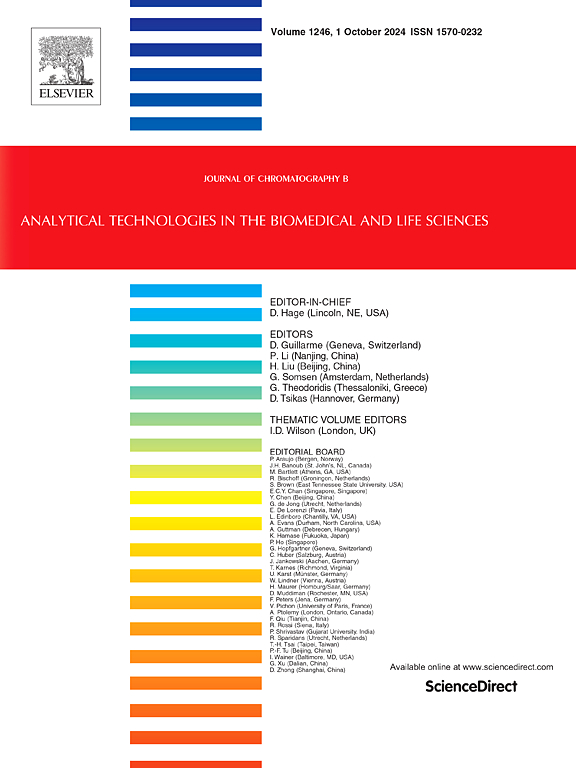中药白术生、炮制丸口服后7种有效成分的药动学比较
IF 2.8
3区 医学
Q2 BIOCHEMICAL RESEARCH METHODS
引用次数: 0
摘要
枳实丸是一种中药,多年来被广泛应用于治疗脾虚和便秘。白术是一种常用的中药方剂,在中药复方中究竟使用生白术还是烧制白术一直存在争议。本研究建立了一种特异、灵敏、快速、准确的液相色谱-串联质谱法(UHPLC-MS/MS)分析ZZP中主要有效成分的方法。测定苍术内酯I、苍术内酯III、辛弗林、荷叶碱、Narirutin、Naringin、橙皮苷在大鼠血浆、组织、尿液、粪便等不同生物基质中的含量。以甘草素为内标。所有生物样品均采用乙腈和甲醇(1:1,V/V)的简单蛋白质沉淀法制备。色谱柱为waters UPLC HSS T3 (100 × 2.1 mm, 1.8 μm)柱。以0.1%甲酸水溶液(A)- 0.1%甲酸乙腈(B)为流动相分离了7种内源干扰物。采用正负离子多重反应监测(MRM)模式,采用三重四极杆质谱仪对各组分进行检测。本方法成功地应用于大鼠灌胃与RRAM或BRAM组成的ZZP后7种成分的药代动力学、组织分布和排泄。药动学结果表明,7种有效成分均能快速吸收,并经过肠肝循环。结果表明,灌胃BRAM的ZZP组大鼠血浆中灯叶碱、Narirutin、柚皮苷和橙皮苷的Cmax高于RRAM组。在组织分布上,七种有效成分主要分布于胃、大肠和小肠。结果表明,与RRAM相比,经胃给药ZZP组BRAM后,胃、大肠和小肠中苍术内酯I、苍术内酯III的Cmax较低。BRAM组成的ZZP灌胃后胃、大肠和小肠内Narirutin、Naringin和synnephrine的Cmax也高于RRAM。排泄研究结果显示,灌胃后48 h 7种有效成分的尿总排泄率均低于RRAM。同时,由BRAM组成的ZZP灌胃后,7种有效成分的总粪便排泄率高于RRAM。首次揭示了七种有效成分的药代动力学、组织分布和排泄特性。并从药代动力学角度比较BRAM与RRAM的ZZP组成差异。为ZZP在临床的合理应用提供参考。本文章由计算机程序翻译,如有差异,请以英文原文为准。
Pharmacokinetics comparison of seven active components after oral administration of Zhizhu pill using raw and processed Rhizoma Atractylodis Macrocephalae
Zhizhu pills (ZZP) is a Traditional Chinese Medicine that has been extensively applied in the treatment of spleen deficiency and constipation for many years. As a commonly used prescription in Traditional Chinese medicine, there had been a controversy over whether to use raw Rhizoma Atractylodis Macrocephalae (RRAM) or Bran-Fired Rhizoma Atractylodis Macrocephalae (BRAM) in ZZP. In this study, a specific, sensitive, fast and accurate liquid chromatography-tandem mass spectrometry (UHPLC-MS/MS) method was developed to analyze the main active components in ZZP. It was used to determine the compound of Atractylenolide I, Atractylenolide III, Synephrine, Nuciferine, Narirutin, Naringin and Hesperidin in rat various biological matrices (plasma, tissue, urine and feces). The liquiritin was used as the internal standard. All the biological samples were prepared using a simple protein precipitation with acetonitrile and methanol (1:1, V/V). A waters UPLC HSS T3 (100 × 2.1 mm, 1.8 μm) column was used in this research. The mobile phase consisting of 0.1 % aqueous formic acid (A)-0.1 % formic acid in acetonitrile (B) was employed to separate seven components from endogenous interferences. The components were detected with a triple quadrupole mass spectrometer using positive and negative ion multiple reaction monitoring (MRM) mode. The newly developed method was successfully applied to investigate the pharmacokinetics, tissue distribution and excretion of seven components after intragastric administration ZZP which was composed with RRAM or BRAM in rats. The pharmacokinetic results indicated that seven active components can be quickly absorbed and had undergone the enterohepatic circulation. It could also indicate higher Cmax of Nuciferine, Narirutin, Naringin and Hesperidin in the plasma after intragastric administration ZZP compose of BRAM than RRAM. In tissue distribution, the seven active components in ZZP were mainly distributed in the stomach, large intestine and small intestine. It could indicate a lower Cmax of Atractylenolide I, Atractylenolide III in the stomach, large intestine and small intestine after intragastric administration ZZP compose of BRAM compared to RRAM. It could also indicate higher Cmax of Narirutin, Naringin, and Synephrine in the stomach, large intestine and small intestine after intragastric administration ZZP compose of BRAM than RRAM. The results of the excretion study showed that the total urinary excretion rate of the 7 active components at 48 h was lower after intragastric administration ZZP compose of BRAM than RRAM. Meanwhile, the total fecal excretion rate of the 7 active components was higher after intragastric administration ZZP compose of BRAM than RRAM. The pharmacokinetics, tissue distribution and excretion characteristics of seven active components in ZZP were first revealed. It also used to compare the difference of ZZP compose of BRAM than RRAM in the pharmacokinetics perspective. It will provide references for the rationality application of the ZZP in clinical.
求助全文
通过发布文献求助,成功后即可免费获取论文全文。
去求助
来源期刊

Journal of Chromatography B
医学-分析化学
CiteScore
5.60
自引率
3.30%
发文量
306
审稿时长
44 days
期刊介绍:
The Journal of Chromatography B publishes papers on developments in separation science relevant to biology and biomedical research including both fundamental advances and applications. Analytical techniques which may be considered include the various facets of chromatography, electrophoresis and related methods, affinity and immunoaffinity-based methodologies, hyphenated and other multi-dimensional techniques, and microanalytical approaches. The journal also considers articles reporting developments in sample preparation, detection techniques including mass spectrometry, and data handling and analysis.
Developments related to preparative separations for the isolation and purification of components of biological systems may be published, including chromatographic and electrophoretic methods, affinity separations, field flow fractionation and other preparative approaches.
Applications to the analysis of biological systems and samples will be considered when the analytical science contains a significant element of novelty, e.g. a new approach to the separation of a compound, novel combination of analytical techniques, or significantly improved analytical performance.
 求助内容:
求助内容: 应助结果提醒方式:
应助结果提醒方式:


